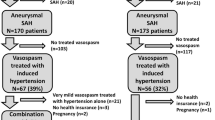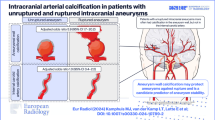Abstract
Purpose
Intracranial vertebral artery dissecting aneurysm (IVADA) is a rare type of aneurysm with high morbidity and mortality. Recently, the application of pipeline embolization devices (PEDs) has been extended to IVADAs. Here, we aim to investigate the safety and effectiveness of PEDs for IVADAs.
Method
We retrospectively reviewed the PLUS database to identify patients who had IVADAs and were treated with PEDs from 2014 to 2019 at 14 centers across China. Data including patient and aneurysm characteristics, procedure details, angiographic and clinical results, relationship with the ipsilateral posterior inferior cerebellar artery (PICA), and patency of the PICA following PED coverage were analyzed.
Results
In this study 52 consecutive patients with 52 IVADAs were included. The mean age was 52.33 years and 82.7% were male. With a median follow-up of 10.5 months, the complete occlusion rate was 93.8% (45/48) and no recurrence or in-stent stenosis was detected. The total postoperative complication rate and mortality were 11.5% and 1.9%, respectively. Complications occurred in 9.6% (5/52) of patients within 30 days after the operation, including ischemic stroke in 3 and hemorrhagic stroke in 2. Another patient suffered an ischemic stroke at follow-up, 78.8% (41/52) PICAs were covered by PEDs, 1 case (2.4%) had a functional disability due to PICA occlusion, while 39.0% (16/41) had reduced flow during follow-up but hardly caused any obvious neurological deficits. Patients with IVADA involving PICA had a trend towards more complications (66.7% vs. 51.1%; P = 1).
Conclusion
Treating IVADAs with PEDs may be a safe and effective option, with favorable clinical and angiographic outcomes; however, complications associated with this treatment should not be ignored.
Registration
http://www.clinicaltrials.gov. Unique identifier: NCT03831672

Similar content being viewed by others
References
Santos-Franco JA, Zenteno M, Lee A. Dissecting aneurysms of the vertebrobasilar system. A comprehensive review on natural history and treatment options. Neurosurg Rev. 2008;31(2):131–40. https://doi.org/10.1007/s10143-008-0124-x. discussion 140.
Sikkema T, Uyttenboogaart M, Eshghi O, De Keyser J, Brouns R, van Dijk JM, Luijckx GJ. Intracranial artery dissection. Eur J Neurol. 2014;21(6):820–6. https://doi.org/10.1111/ene.12384.
Debette S, Compter A, Labeyrie MA, Uyttenboogaart M, Metso TM, Majersik JJ, Goeggel-Simonetti B, Engelter ST, Pezzini A, Bijlenga P, Southerland AM, Naggara O, Bejot Y, Cole JW, Ducros A, Giacalone G, Schilling S, Reiner P, Sarikaya H, Welleweerd JC, Kappelle LJ, de Borst GJ, Bonati LH, Jung S, Thijs V, Martin JJ, Brandt T, Grond-Ginsbach C, Kloss M, Mizutani T, Minematsu K, Meschia JF, Pereira VM, Bersano A, Touze E, Lyrer PA, Leys D, Chabriat H, Markus HS, Worrall BB, Chabrier S, Baumgartner R, Stapf C, Tatlisumak T, Arnold M, Bousser MG. Epidemiology, pathophysiology, diagnosis, and management of intracranial artery dissection. Lancet Neurol. 2015;14(6):640–54. https://doi.org/10.1016/S1474-4422.
Balik V, Yamada Y, Talari S, Kei Y, Sano H, Suyama D, Kawase T, Takagi K, Takizawa K, Kato Y. State-of-art in surgical treatment of dissecting posterior circulation intracranial aneurysms. Neurosurg Rev. 2018;41(1):31–45. https://doi.org/10.1007/s10143-016-0749-0.
Sonmez O, Brinjikji W, Murad MH, Lanzino G. Deconstructive and Reconstructive Techniques in Treatment of Vertebrobasilar Dissecting Aneurysms: A Systematic Review and Meta-Analysis. Ajnr Am J Neuroradiol. 2015;36(7):1293–8. https://doi.org/10.3174/ajnr.A4360.
Kim BM, Shin YS, Kim SH, Suh SH, Ihn YK, Kim DI, Kim DJ, Park SI. Incidence and risk factors of recurrence after endovascular treatment of intracranial vertebrobasilar dissecting aneurysms. Stroke. 2011;42(9):2425–30. https://doi.org/10.1161/STROKEAHA.111.617381.
Becske T, Kallmes DF, Saatci I, McDougall CG, Szikora I, Lanzino G, Moran CJ, Woo HH, Lopes DK, Berez AL, Cher DJ, Siddiqui AH, Levy EI, Albuquerque FC, Fiorella DJ, Berentei Z, Marosfoi M, Cekirge SH, Nelson PK. Pipeline for uncoilable or failed aneurysms: results from a multicenter clinical trial. Radiology. 2013;267(3):858–68. https://doi.org/10.1148/radiol.13120099.
Luo B, Kang H, Zhang H, Li T, Liu J, Song D, Zhao Y, Guan S, Maimaitili A, Wang Y, Feng W, Wang Y, Wan J, Mao G, Shi H, Yang X. Pipeline Embolization device for intracranial aneurysms in a large Chinese cohort: factors related to aneurysm occlusion. Ther Adv Neurol Disord. 2020;13:1756286420967828. https://doi.org/10.1177/1756286420967828.
de Barros MF, Castro RN, Lundquist J, Scrivano E, Ceratto R, Ferrario A, Lylyk P. The role of the pipeline embolization device for the treatment of dissecting intracranial aneurysms. Ajnr Am J Neuroradiol. 2011;32(11):2192–5. https://doi.org/10.3174/ajnr.A2671.
Yeung TW, Lai V, Lau HY, Poon WL, Tan CB, Wong YC. Long-term outcome of endovascular reconstruction with the Pipeline embolization device in the management of unruptured dissecting aneurysms of the intracranial vertebral artery. J Neurosurg. 2012;116(4):882–7. https://doi.org/10.3171/2011.12.JNS111514.
Chan RS, Mak CH, Wong AK, Chan KY, Leung KM. Use of the pipeline embolization device to treat recently ruptured dissecting cerebral aneurysms. Interv Neuroradiol. 2014;20(4):436–41. https://doi.org/10.15274/INR-2014-10042.
Albuquerque FC, Park MS, Abla AA, Crowley RW, Ducruet AF, McDougall CG. A reappraisal of the Pipeline embolization device for the treatment of posterior circulation aneurysms. J Neurointerv Surg. 2015;7(9):641–5. https://doi.org/10.1136/neurintsurg-2014-011340.
Kuhn AL, Kan P, Massari F, Lozano JD, Hou SY, Howk M, Gounis MJ, Wakhloo AK, Puri AS. Endovascular reconstruction of unruptured intradural vertebral artery dissecting aneurysms with the Pipeline embolization device. J Neurointerv Surg. 2016;8(10):1048–51. https://doi.org/10.1136/neurintsurg-2015-012028.
Cerejo R, Bain M, Moore N, Hardman J, Bauer A, Hussain MS, Masaryk T, Rasmussen P, Toth G. Flow diverter treatment of intracranial vertebral artery dissecting pseudoaneurysms. J Neurointerv Surg. 2017;9(11):1064–8. https://doi.org/10.1136/neurintsurg-2017-013020.
Corley JA, Zomorodi A, Gonzalez LF. Treatment of Dissecting Distal Vertebral Artery (V4) Aneurysms With Flow Diverters. Oper Neurosurg. 2018;15(1):1–9. https://doi.org/10.1093/ons/opx180.
Turhon M, Kang H, Li M, Liu J, Zhang Y, Zhang Y, Huang J, Luo B, Liu J, Zhang H, Li T, Song D, Zhao Y, Guan S, Aximujiang A, Maimaitili A, Wang Y, Feng W, Wang Y, Wan J, Mao G, Shi H, Zhang X, Gu Y, Yang X. Treatment of fusiform aneurysms with a pipeline embolization device: a multicenter cohort study. J Neurointerv Surg. 2023;15(4):315–20. https://doi.org/10.1136/neurintsurg-2021-018539.
Gupta G, Eckstein DA, Narayan V, Jumah F, DePalma AA, Sozio SJ, Prendergast N, Schonfeld S, Keller I, Al-Mufti F, Nosko M, Nanda A, Roychowdhury S. Endovascular Management of Intracranial Vertebral Artery Dissection: Technical Nuances for the Preservation of Posterior Inferior Cerebellar Artery and Basilar Artery. Oper Neurosurg. 2020;19(3):241–8. https://doi.org/10.1093/ons/opaa174.
John S, Bain MD, Hui FK, Hussain MS, Masaryk TJ, Rasmussen PA, Toth G. Long-term Follow-up of In-stent Stenosis After Pipeline Flow Diversion Treatment of Intracranial Aneurysms. Neurosurgery. 2016;78(6):862–7. https://doi.org/10.1227/NEU.0000000000001146.
O’Kelly J, Krings CT, Fiorella D, Marotta TR. A novel grading scale for the angiographic assessment of intracranial aneurysms treated using flow diverting stents. Interv Neuroradiol. 2010;16(2):133–7. https://doi.org/10.1177/159101991001600204.
Kadirvel R, Ding YH, Dai D, Rezek I, Lewis DA, Kallmes DF. Cellular mechanisms of aneurysm occlusion after treatment with a flow diverter. Radiology. 2014;270(2):394–9. https://doi.org/10.1148/radiol.13130796.
Mazur MD, Kilburg C, Wang V, Taussky P. Pipeline embolization device for the treatment of vertebral artery aneurysms: the fate of covered branch vessels. J Neurointerv Surg. 2016;8(10):1041–7. https://doi.org/10.1136/neurintsurg-2015-012040.
Wu X, Tian Z, Liu J, Zhang Y, Li W, Zhang Y, Chen J, Zhou Y, Yang X, Mu S. Patency of Posterior Circulation Branches Covered by Flow Diverter Device: A Hemodynamic Study. Front Neurol. 2019;10:658. https://doi.org/10.3389/fneur.2019.00658.
Matsukawa H, Shinoda M, Fujii M, Takahashi O, Uemura A, Niimi Y. Basilar extension and posterior inferior cerebellar artery involvement as risk factors for progression of the unruptured spontaneous intradural vertebral artery dissection. J Neurol Neurosurg Psychiatry. 2014;85(9):1049–54. https://doi.org/10.1136/jnnp-2013-306931.
Li W, Zhu W, Wang A, Zhang G, Zhang Y, Wang K, Zhang Y, Wang C, Zhang L, Zhao H, Wang P, Chen K, Liu J, Yang X. Effect of Adjusted Antiplatelet Therapy on Preventing Ischemic Events After Stenting for Intracranial Aneurysms. Stroke. 2021;52(12):3815–25. https://doi.org/10.1161/STROKEAHA.120.032989.
Acknowledgements
The authors acknowledge the 14 centers for their cooperation. Ying Zhang and Fujunhui Zhang share first authorship.
Funding
This work was supported by the National Natural Science Foundation of China (grant numbers: 82072036, 82272092), Research Projects of National Health Commission Capacity Building and Continuing Education Centre in 2021 (grant number: GWJJ2021100103); Capital’s Funds for Health Improvement and Research (grant number: 2022-01-2041); Summit Talent Program (grant number: DFL20220504).
Author information
Authors and Affiliations
Contributions
Ying Zhang: conceptualization, supervision, methodology, writing—revised draft, review and editing; Fujunhui Zhang: writing—original draft, formal analysis, data curation, software; Mizart Turhon: writing—review and editing; Jiliang Huang, Mengxing Li, Qichen Peng, Zhaoxu Zheng: data curation, investigation; Jian Liu: conceptualization, supervision, validation, funding acquisition; Yisen Zhang: conceptualization, supervision, validation; Jianmin Liu, Hongqi Zhang, Tianxiao Li, Donglei Song, Yuanli Zhao, Maimaitili Aisha, Yunyan Wang, Wenfeng Feng, Yang Wang, Jieqing Wan, Guohua Mao, Huaizhang Shi, Sheng Guan: resources, investigation. All authors have read the manuscript and consented to publication.
Corresponding author
Ethics declarations
Conflict of interest
Y. Zhang, F. Zhang, M. Turhon, J. Huang, M. Li, Q. Peng, Z. Zheng, J. Liu, Y. Zhang, J. Liu, H. Zhang, T. Li, D. Song, Y. Zhao, M. Aisha, Y. Wang, W. Feng, Y. Wang, J. Wan, G. Mao, H. Shi and S. Guan declare that they have no relevant financial or non-financial interests to disclose.
Ethical standards
All human and animal studies have been approved by the appropriate ethics committee and have therefore been performed in accordance with the ethical standards laid down in the 1964 Declaration of Helsinki and its later amendments. The institutional review boards and ethics committee of Beijing Tiantan Hospital, Capital Medical University reviewed and approved the study protocol (approval No KY 2018-098-02). Participants gave informed consent to participate in the study before taking part.
Additional information
Ying Zhang and Fujunhui Zhang share first authorship.
Availability of Data and Materials
The data supporting the findings of this study are available from the corresponding author upon reasonable request.
Supplementary Information
62_2023_1318_MOESM1_ESM.doc
Supplementary Fig. 1: SAH Case. A Emergency CT showing SAH. B Right vertebral artery angiography showing a dissecting aneurysm located below PICA (pre-PICA) and far away from PICA three months later. C The aneurysm was treated with a PED alone (black arrow). D Right vertebral artery angiography showing complete aneurysm occlusion at 6‑months follow-up.
62_2023_1318_MOESM2_ESM.docx
Supplementary table 1: Comparison of main factors characterizing postoperative complications (one patient with SAH was excluded). Compared to the non-complication group, there were fewer patients underwent platelet function testing (0% vs. 22.2%; P= 0.331) but more patients with aneurysms involving the posterior inferior cerebellar artery (66.7% vs. 51.1%; P=1) in the complication group, but these findings did not achieve statistical significance.
Rights and permissions
Springer Nature or its licensor (e.g. a society or other partner) holds exclusive rights to this article under a publishing agreement with the author(s) or other rightsholder(s); author self-archiving of the accepted manuscript version of this article is solely governed by the terms of such publishing agreement and applicable law.
About this article
Cite this article
Zhang, Y., Zhang, F., Turhon, M. et al. Treatment of Intracranial Vertebral Artery Dissecting Aneurysms Using Pipeline Embolization Devices. Clin Neuroradiol 33, 1105–1114 (2023). https://doi.org/10.1007/s00062-023-01318-7
Received:
Accepted:
Published:
Issue Date:
DOI: https://doi.org/10.1007/s00062-023-01318-7




